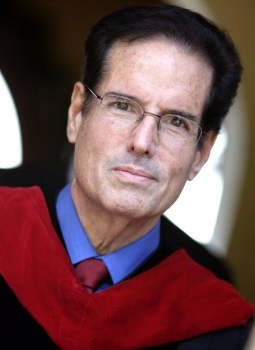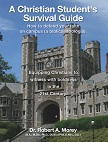The Meaning, Mode, and Subjects of Baptism
By Dr. Robert A. Morey
https://njiat.com/apologetics.html
To discover the mind of God concerning the meaning, mode, and subjects of baptism is not as simple as it seems on the surface. Sacramentalists go outside of Scripture and appeal to the “Fathers” of the church, tradition, creeds, councils, and confessions.
That Eastern Orthodox and Roman Catholic communions feel no need to submit to the absolute authority of Holy Writ is not surprising. They never claimed to follow the principle of sola scriptura and openly reject it. But what is surprising is when Protestants, particularly the Reformed, who supposedly believe in sola scriptura abandon it and turn to some form of sacramentalism. This is a sad example of “selective” and “arbitrary” hermeneutics as well as the logical fallacy of “special pleading.”
The only thing consistent about man is his inconsistency and hypocrisy. He will attempt to speak out of both sides of his mouth, both condemning and affirming the same principle. Our depravity tempts us to compromise our principles in the vain hope that good may come from doing evil.
The First Task
The first task in theology 101 is to decide whether God or man is the Origin of truth, justice, morals, meaning, and beauty. Is the transcendent opinion of God as infallibly revealed in Scripture the Origin and Judge of theological truth? Or, is the fallible opinion of man the Origin and Judge?
It does not matter if we talking about the personal opinion of a single theologian, for example John Calvin, or a creed, for example the Westminster Confession of Faith, which is the fallible expression of the personal opinions of a group of men.
The same choice applies to those who choose their own subjective fallible reason, experience, feelings or faith as the Origin and Judge. What they believe and how they live is decided by looking within themselves to some part of their being that they have arbitrarily absolutized into the Origin of truth, justice, morals, meaning, and beauty.
“No man can serve two masters.”
In the end, you will have to decide who has the final and ultimate authority to decide what you believe and how you live. God or man? But make sure you choose wisely by looking down the road to see where you will end up.
Some of my seminary friends are now apostate. They chose to become “confessional” theologians instead of exegetical theologians. The more weight they gave to traditions, the Fathers, creeds, councils, and confessions, the less weight they gave to Scripture. Just as the moon can eclipse the light of the sun, the fallible opinions of man eventually eclipsed the infallible Word of God. They eventually left the Faith and ended up in Eastern Orthodoxy or in Roman Catholicism. Once they gave up sola scriptura, they slid down the slippery slope into the bottomless pit of apostasy.
Look Before You Leap
The choice in the end is between being a theist or a humanist. It really doesn’t matter what issue of truth or morals is being discussed. You have to choose either the Lordship of Christ or the lordship of man.
Assignment #1 Define, document, and defend how you are going to decide the issue of baptism.
If you follow the example of the prophets, apostles, and Jesus, you will let Scripture alone decide doctrine and morals. For example, when Paul explained WHY he believed that Messiah died for his sins, he said, “according to the Scriptures” (1 Cor. 15:3-4). Thus those who follow the example of the authors of Scripture will chose Scripture as their final authority in all matters of faith and practice.
Not Solo Scriptura
Does this mean that we ignore the opinions of individuals, churches, councils, and creeds? No. Although their opinions are subjective, personal, and fallible, they should be consulted to make sure that you have not come up with some weird interpretation of Scripture.
Jude 3 indicates that the “Faith” was delivered once for all of time in the days of the apostles. If a doctrine is truly new, then it is not true. If it is true, then it will not be new.
If you are alone in your interpretation of some passage, this does not bode well. Christians for two thousand years have been reading the Bible and if your interpretation has no historical pedigree, it is probably wrong. The church has not been holding its breath waiting for you to come along!
While we do give some weight to the personal opinions of men as a safeguard against conceit, the Bible alone is the final authority in all matters of faith and practice.
“Let God be true even if it means that
all men are liars.” (Rom. 3:4)
The Second Task
The second task is to take seriously that your understanding of the nature of the church, the Body of Christ, will play a major role in your understanding of the ceremonies of the church. What the church IS has to be decided before you can define what it DOES.
- The concept of a national “covenant” was pervasive in pre-biblical ancient Middle Eastern societies. They were called Suzerainty covenants.
- The society encompassed the state and the religion. The two were one and the same thing.
- Israel was a nation that was covenantal in this sense.
- This covenant embraced all who lived in the land of Israel including any Gentiles called “strangers.”
- Membership in the covenant was mandatory politically and religiously. Anyone, Jew or Gentile, who lived in the land, had to be made a part of the state/church.
- People were enrolled in the national covenant at birth through circumcision.
- Anyone who failed to join the covenant nation via infant circumcision was put to death. (Gen. 17:9-14; Exo. 4:24-26; 12:48-49).
- The covenantal nation had national boundaries, guards, soldiers, and an official religion that did not tolerate any other religions in the land.
- The sword of the state was also the sword of the church and the state put to death those who violated the teachings and laws of the religion as well as punishing the civil laws of the state.
- The national covenant did not allow freedom of choice. You were enrolled from birth and could not opt out of the religion. To leave the religion was to commit treason against the state and was punishable by death at the hands of the civil authorities.
- The covenantal union of the state with an official religion is called a “sacral” society because a mandatory common religion was the glue that held the nation together.
- All ancient nations were sacral societies that had a mandatory national religion.
- The New Testament made a clean break with the sacral society model and taught the Church was no longer limited to one nation or one race.
- The church has no national boundaries, no border guards, no soldiers, no courts, no policemen, no jails, no execution chambers, no taxes, no civil laws, and no physical swords. (John 18:36; 2 Cor. 10:3-4). Its discipline is moral, not physical (1 Cor. 5:1-5)
- The separation between state and church was summed up by Jesus when he said that we are should render to God what belongs to God and to Caesar what belongs to Caesar. We must not confuse God and Caesar or merge them into one unit.
- The Church as the new covenant community was to move into all nations and races would no longer be identified with a nation, race or ethnic group. People from every tribe and tongue would sing the praises of Jesus.
- Christianity is not a sacral religion. It is always “in” a society and must never be identified as that society.
- It is no longer the mandatory glue that holds a society together. The church is part of a multi-cultural and multi-religious society in which it must compete in the market place of ideas with all other religions.
- It does not coerce people into joining the church at the point of a gun. It must use moral and intellectual arguments instead of coercion.
- Mandatory enrollment at birth was an integral part of a sacral society. But once God terminated the Old sacral society, there was no longer any need or justification for infant enrollment.
- There is no command, example or precept in the New Covenant Scriptures to enroll infants into a sacral society because baptism was a voluntary outward ceremony that celebrated an inner salvation.
- The early Church did not enroll infants into a sacral society through baptism because there was no sacral society.
- Neither did it use physical violence to coerce people into baptizing their children, attending church or maintaining correct doctrines.
- Once Constantine adopted Christianity as the religion that would hold together the sacral society of the Roman Empire, the church and the state became one again.
- The pre-Christian pagan sacral society of Rome already had a term to describe the mandatory ceremonies connected with official religion. They were called “sacraments.”
- The sacral society now used the word “sacrament” to describe the new ceremonies of the new religion.
- The pre-Christian pagan sacral society of Rome had a priestly class of state approved religious leaders who officiated at sacral ceremonies. The new sacral society recast the elders of the church into the model of the old priestcraft.
- The pre-Christian pagan sacral priests wore brightly colored robes and vestments that revealed their rank and power in society. These vestments were adopted by Christian clergymen.
- The sacramentalism and priestcraft of Roman Catholicism in many aspects was nothing more than pre-Christian pagan sacral religion.
- The Reformers retained the sacral society model and merely sought to exchange the official religion of their nations from popery to Protestantism.
- They mandated infant baptism as the means to enroll people into the state and church sacral union. Capital punishment was the punishment for failing to enroll your children into the sacral society.
- After the Thirty Years War, Europe was divided into three religious zones: Reformed, Lutheran, Roman Catholic. Every person born into a region had to be part of the religion that was the official religion of the region under the penalty of death.
- The creeds that came out of the Reformation had the civil authorities administering church discipline. They claimed that the church had two swords to use, one civil and one spiritual. The Belgic Confession’s Article 36 and the Westminster Confession of Faith both have the police administering church discipline.
- Those who wanted to return to the pre-sacral church of the New Testament taught the separation of the church and state. The Church was composed of those who professed faith in Jesus as God and Lord.
- There had always been Christians who opposed the sacral society model of the church state and preached a pure church of believers only. They did not want any coercion of any kind used in evangelism and discipline. They saw the church as in a society and not as the society itself.
- It did not make much difference to them who was persecuting them. Pagan, Catholic, and Protestant sacral societies all persecuted anyone who did not bow to the authority of the state church.
- Zwingli came closest to the New Testament concept of the church and said infant baptism should not be practiced. But the civil authorities took over the affairs of the church and he submitted to their demand that a sacral society be established. They went on to demand that all must baptize their children and enroll them in the state/church under penalty of death.
- The recent “confessional” movement among Calvinistic theologians toward sacramentalism is disturbing. They take a neo-Catholic view of baptism and the Lord’s Supper and proclaim them “sacraments” that are “means of grace” that sounds like ex opera operato to me. Some claim that the mere act of eating the “sacrament” of “Holy Communion” grants them forgiveness of sins. They claim that baptism infuses some kind of “grace” into the infant. The cliché “Let us put the amazing back into grace” is used to justify neo-Catholic magical views of the bread, water, and wine.
- Some of the “kingdom now” theologians loudly call for a return to a “Christian” sacral society. Of course, this is an oxymoron. If it is sacral it cannot be Christian and if it is Christian it cannot be sacral. Only members of the official state/church are allowed to hold office. Baptists and others who refuse to join the sacral society will be imprisoned as traitors to the state. Gary North told me that he would have to put me in jail even though we were friends!
I. The Origin of Baptism
The first reference to baptism in the New Testament is the baptism administered by John, the forerunner of the Messiah (Mat. 3:1; Mark 1:4). His use of this ceremony was so unique and remarkable that he became identified by it, i.e. “John the Baptist.” What was so remarkable about his baptism?
- First, everyone agrees that John did not introduce a new ceremony. In all four Gospels no one challenged John for inventing something new. John was doing something that others had done before him.
- Since baptism was a pre-existing ceremony before John, there are only so many possible origins:
1. Old Testament:
(a. There are no direct references in the O.T. to a baptism ceremony like John’s baptism or Christian baptism.
(b. The author of Hebrews referred to “baptisms,” i.e. “washings” in Heb. 6:2 (baptismw/n) and 9:10 (baptismoi/j). This is the only time it is found in the plural and refers to “various kinds of baptisms” (diafo,roij baptismoi/j(). But it is not at all clear if the Old Testament is in view.
(c. While the words baptism and baptisms are not found in the Septuagint, the root word bapto is found in Lev. 4:6,17; 14:6, 16, 51; Num. 19:18; Deut. 33:24; Exo. 12:22; Ruth 2:14. It means to immerse or dip and is used in contrast to the word “sprinkle” (prosrai,nw).
(d. Mark 7:4 refers to the “washing,” i.e. “baptism” of items brought into the house. There really isn’t any O.T. precedent for the “baptisms” of pot and pans.
2. Intertestamental Jewish literature:
(a. The key to both Mark and Hebrews is to look- not to the O.T. - but to Judaism during the intertestamental period, between Malachi and Matthew.
(b. For example, the Mishnah speaks of immersing yourself and any items you brought into the house from the market place. Why? Someone ceremonially unclean could have touched you or that item. Thus the “baptism” was a ceremony that washed away ceremonial uncleanness.
(c. Note: The Jews did not have any magical or mystical interpretation of their ceremonies, including ceremonial baptism. The Essenes practiced daily baptisms.
(d. Nineteenth century reference works desperately tried to find O.T. references to explain the “baptisms” mentioned in Hebrew and Mark. They did this because they did not have access to or know of early Jewish literature, including the Dead Sea Scrolls.
(e. It is important to check the reference work you are using to see if it is out of date. If it was written in the 19th century, it may be out-of-date.
(f. Check to see if the author cites from the Midrash, Mishnah, Talmuds, pseudopigrapha, Apocrypha. Dead Sea Scrolls, etc. If the author does not cite early Jewish literature, his research was inadequate.
(g. The intertestamental literature explains why there was a messianic and apocalyptic element to John’s baptism (John 1:25). Scholars have searched the OT to find passages that led the Jews to believe that the coming of the Messiah and Elijah would include water baptism. The only prophecy that puts together Messiah and Elijah with purification is found in Mal. 3:1-4; 4:5-6.
3. 1st Century Jerusalem archeological discoveries:
(a. If a scholar does not refer to all the wonderful archeological discoveries made in Israel in the last fifty years, he is out-of-date. For example, the modern work of Nahman Avigad in his work, Discovering Jerusalem, is must reading to understand first century Jerusalem.
(b. Avigad demonstrates (pgs. 139f) that the Pharisees had immersion pools in their homes in which they “baptized” items brought into the house as well as themselves. This explains Mark and Hebrews.
(c. Beware of fraudulent claims made by the best of men. When it dawned upon pedobaptists that they did not have any Jewish pedigree for infant baptism, they invented the bogus idea that intertestamental Jews baptized the children of Gentile converts. Even J. B. Lightfoot, fell into this trap! Look for the footnotes to indicate where in the Jewish literature this is taught. If they give you one, look it up. But you will not find any footnotes because it was not historically true. It is only an example of the psychological power of wish fulfillment.
4. Pagan Origins:
Since the beginning of the 20th century, liberalism has claimed that Paul created Christianity out of the pagan religions of his day. Some of the ancient mystery religions initiated new members into their cult through a form of secret baptisms. Their baptisms are sometimes identified as the origin of Christian baptism. I refuted this lie in my books on atheism and the Trinity.
II. The Meaning of Baptism:
- Objectively, baptism is a dramatic portrayal of the death, burial and resurrection of Christ (Rom. 6:1-11). In baptism we are reminded afresh that Jesus died for our sins and was raised for our justification (Rom. 4:25). Thus baptism has as its initial focus the person and work of Christ.
- Subjectively, baptism is a dramatic portrayal of union with Christ in His death and resurrection. Baptism thus symbolizes that the person baptized died with Christ, rose with Christ, and now walks in newness of life with Christ (Rom. 6:1-11; Gal. 2:20; 5:24; 6:14). This is its primary meaning in the New Testament.
- In a secondary sense, baptism also symbolizes regeneration, the forgiveness of sins, and the coming of the Holy Spirit (Tit. 3:5; Eph. 5:26; Col. 2:12-13; I Cor. 6:11; Acts 22:16; Mk. 1:8, etc.).
- Baptism is thus an outward act that symbolizes an inward reality (1 Pet. 3:21). And, we must remember, a symbol always points away from itself to the reality it portrays. Just as the symbolic ceremonies of the Old Testament, such as animal sacrifices, could not accomplish what they symbolized (Heb. 10:1-4), even so baptism cannot save, regenerate or wash away sin. We must not confuse symbol and reality. Which is greater, the shadow or what casts the shadow?
- The confusion of a symbol with the reality it portrays is the basis of all vain and superstitious views of baptism and the Lord's Supper. The bread and the wine are symbols of the body and blood of Jesus and should not be viewed as actually being what they symbolize.
- While baptism symbolizes salvation, it does not accomplish it. The person baptized may actually not be saved as in the case of Simon (Acts 8:13; 18-23). Thus baptism has in focus the profession of salvation and is not a magical act guaranteeing the possession of salvation.
III. The Mode of Baptism
- Once the primary meaning of baptism is understood, the way it is carried out is also obvious. Immersion is the only mode of baptism that portrays the objective symbolism of Christ's death, burial and resurrection as well as the subjective symbolism of union with Christ and the salvation that results from that union. While sprinkling and pouring can symbolize regeneration, the forgiveness of sins and the coming of the Spirit, both modes fail to point us to the death and resurrection of Christ. They fail to be Christological in essence or practice.
- If we examine the vocabulary used in the New Testament to describe this ceremony, we find that such words as bapto, baptizein, etc. are used. To discover what these words meant, we examined 38 Greek Lexicons and Dictionaries. All of these works without exception defined bapto "to immerse, to submerge or to dip or to dye." We could not find a single Greek reference work that translated bapto, etc., as "sprinkle" or "pour." The Greek language has other words for sprinkle and pour.
- Immersion is the meaning of these words in the Septuagint. The contrast with sprinkle is plain in such places as Lev. 4:6, etc.
- All the extra-Biblical uses of these words mean to immerse.
- The usage and context of these words in the New Testament clearly mean to immerse. (See: Matt. 26:23; Lk. 16:24, etc.)
- The need for abundant water is only understandable if immersion is the mode in view. (see: Matt. 3:6; John 3:23; Acts 8:36, etc.)
- The prepositions "into" and "out of" imply immersion. (see: Acts 8:38, etc.).
- The Jews baptized by immersion before Christ was born. The Mishnah and archaeology make this clear. Thus baptism by immersion already existed when John the Baptist started to baptize. There is no evidence of sprinkling or pouring.
- All Greek Orthodox, Roman Catholic and Protestant scholars admit that immersion was the original mode. ex. John Calvin on John 3:23. “Moreover, from these words we may infer that John and Christ administered baptism by total immersion."
IV. The Subjects of Baptism
- Once the biblical meaning and mode of baptism is understood, the question as to who should be baptized is rather obvious. The symbolic nature of baptism requires that the person baptized be viewed as having already experienced the reality which baptism symbolizes. Thus, only those who professed to be saved by faith in the Lord Jesus were baptized in the New Testament. The order was always faith then baptism.
- To give baptism to infants, children or adults who do not or cannot confess faith in Christ destroys both the objective and subjective meanings of baptism. To baptize someone who is not in union with Christ, who did not die and rise with Christ, who is not regenerate, whose sins are not forgiven is a mockery of the Gospel.
- Infant baptism, along with forced baptism, was a natural outgrowth of a superstitious view of baptism in which baptism was thought to accomplish salvation instead of just symbolizing it. Infants and unbelieving adults were baptized, because it was believed that the mere act of baptism would save them without faith on their part.
- There are no examples or commands in the New Testament that infants and unbelieving children or adults are to be baptized. There is no passage in the New Testament that teaches that baptism is proper for unbelievers regardless of their age or condition.
V. Church History
- The first reference to infant baptism in Church History is by Tertullian who opposed it! (See: Tertullian's work On Baptism, chap. XVII in A.N.F., vol. III, p. 678.)
- The baptism of infants and adult unbelievers arose only after the doctrine of baptismal regeneration was accepted.
- Even by A.D. 354, infant baptism was still not the norm because Augustine himself was not baptized as an infant even though his mother was a devout Christian.
VI. The Significance of Baptism
- Baptism is for believers, the children of God, disciples of Christ, repentant sinners, i.e. for Christians. We do not baptize those who are unbelieving, unrepentant sinners, the children of the devil.
- By baptism we publicly identify ourselves with Christ and with His Church. Once baptized, we can join the Church and eat at the Lord's Table along with our brothers and sisters in Christ.
- Once in the Body, we learn to share the joys and sorrows of the people of God. Baptism is thus the opening of a door to greater fellowship and ministry as well as obedience to the Lord of the Church who told us to make disciples and then to baptize them in the name of the Father and of the Son and of the Holy Spirit (Matt. 28:l9-20).






































